One of Mangalore’s most traditional beverages is a freshly brewed coffee sweetened with palm jaggery (obtained from the Palmyra palm, commonly known as the ‘Eerol/Irvol fruit tree). While some people prefer having it plain without milk (called as ‘puti kapi’) some add some creamy whole milk to it that helps create a beautiful blend of milky goodness. I was introduced to this version of the coffee (with palm jaggery) after I delivered my second baby a couple of years ago. Till then, I had only heard about the godachi kapi. The term ‘god’ stands for jaggery in Konkani. In Mangalore we popularly use two types of jaggery, the most common one is made from unrefined sugarcane juice (called as just ‘god’ or ‘kobache god’ where ‘kobu’ stands for sugarcane) and the other called as ‘pele (pelem) /pelyache god or ‘surai god’ which is obtained from the palmyra tree. The stack of jaggery discs is called as the ‘pelo’ and ‘surai’ means one that is obtained from ‘sur’ or toddy. The third and less popular variety is the coconut palm jaggery called as ‘narli god’ which is obtained from the toddy of the coconut tree. They say that it is pretty hard to tell the difference between the last two as both are sold in stacks of 12-14 discs and look similar in colour and aroma. If I manage to unravel the mystery on my next trip to Mangalore I will definitely share the information with you.
Till I started blogging I didn’t know where the ‘pele god’ was obtained from. After doing plenty of research I found out that it was from the palmyra tree botanically called as Borassus flabellifer L, which is famous for the 3 eyed pulpy fruit called as ‘Ice Apple’. The fruit is black on the outside, pretty much like brinjals and when sliced open reveals 2 or 3 translucent, fleshy pods that contain sweet juice, a lot like coconut water but mostly sweeter. After you’ve bitten into the pod and enjoyed the juice you can eat the pulp as well. This is famous on the beaches of Mangalore and my fondest memories take me back to the time when we used to go to the beach for picnics and enjoyed some ice apples on our way back.
Like I mentioned earlier, I was served this coffee during my confinement period the second time around. The lady who came to take care of me and my baby (the ‘balnti posteli’ as we call her) said that brewed coffee with palm jaggery is supposed to help cool the body if consumed in small quantities and at the right time of day. Since I know that a lot of people find coffee as a ‘heaty’ beverage I didn’t dispute her claims. Now while researching the net I am given to understand that as per Ayurveda, freshly brewed coffee, if consumed between 6am and 10am can actually help those with ‘kapha dosha’ to get rid of their sluggishness as it stimulates the mind and the agni (digestive fire). However, since I didn’t find a lot of information on this I will leave you to do your research before you consume this coffee for anything but for the sake of pure pleasure that it gives. If you are a die hard coffee lover like I am, go ahead and have a freshly brewed cuppa – it is definitely healthier than the instant coffee which has artificial flavours added to it to give it that fabulous taste.
Most brands of coffee powder are available in two kinds of grinds (texture) – the fine and the slightly coarse variety. The coarse variety is prepared especially for the South Indian filter apparatus made of steel, which has an upper compartment and a lower compartment separated by a perforated plate. You are required to place your coarsely ground coffee powder on the perforated plate and pour boiling water into the upper compartment. The water that dribbles down, passes through the perforation and turns into a thick coffee decoction that drips into the lower compartment over a period of hours and that’s the secret of our South Indian coffee. Most Mangaloreans however just simply resort to brewing the coffee in a regular pot of boiling water and allowing the coffee grounds (sediment) to settle down before carefully pouring the clear liquid into a serving cup (usually a steel tumbler)
And hey, before I forget – I am starting a new series with this post called as the ‘Kapi-Falhaar‘, a term in Konkani used to define ‘light snacks’ or ‘tea time or mid morning snacks’. It is similar to the term ‘Kaapi Thindi‘ in Kannada and ‘Chai Naashtha‘ in Hindi. I hope that, like the Boshi (Mangalorean Plated Meal) series which I have been posting every Wednesday you will enjoy this series too! Do let me have your feedback on ruchikrandhap@gmail.com
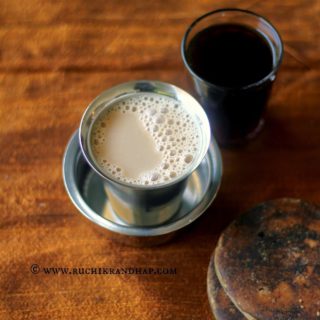
Godachi Kapi ~ Traditional Mangalorean Brewed Coffee Sweetened with Palm Jaggery
One of Mangalore's most traditional beverages is a freshly brewed coffee sweetened with palm jaggery is a real delight for coffee lovers. It's earthy taste is reminiscent of a forgotten era
Print
Pin
Rate
Ingredients
- 1 cup (240ml) water
- 25 grams palm jaggery
- 1 level teaspoon of filter coffee powder * see note#2
- hot milk as required
Instructions
- Place the water & jaggery in a pan/saucepan and bring the mixture to a boil, stir until the jaggery is dissolved.
- When the water comes to a rolling boil, add the coffee powder and let it brew for about 10 seconds. Remove pan from heat
- Place the pan slightly tilted (so that the coffee sediment settles down and you can easily pour the clean liquid) for at least 45 mins – 1 hr
- When the sediment has settled down you will be left with clear liquid – without shaking the pan carefully pour it into a serving cup. Add as much hot milk as you want to make a strong or milky coffee. Serve hot!
Notes
1. If you don’t have palm jaggery you can use cane jaggery (regular jaggery)
2. This recipe requires ground coffee powder that needs to be brewed. Do not use instant coffee powders like Nescafe or Bru. Add 2 teaspoons if you like it strong.
3. If you wish, to create a frothy effect pour the prepared coffee from a height into another pan a couple of times and then serve.
2. This recipe requires ground coffee powder that needs to be brewed. Do not use instant coffee powders like Nescafe or Bru. Add 2 teaspoons if you like it strong.
3. If you wish, to create a frothy effect pour the prepared coffee from a height into another pan a couple of times and then serve.
Disclaimer
The nutritional values are only indicative.
Tried this recipe?Please leave a comment & rate the recipe below or share a photo on Instagram and tag me @ruchikrandhap
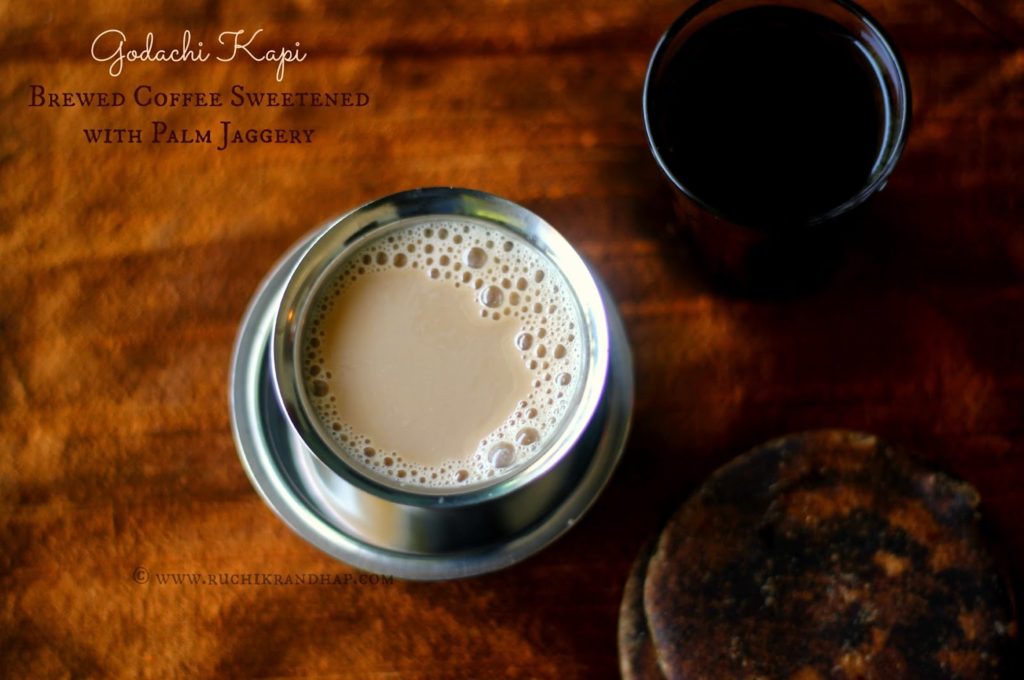
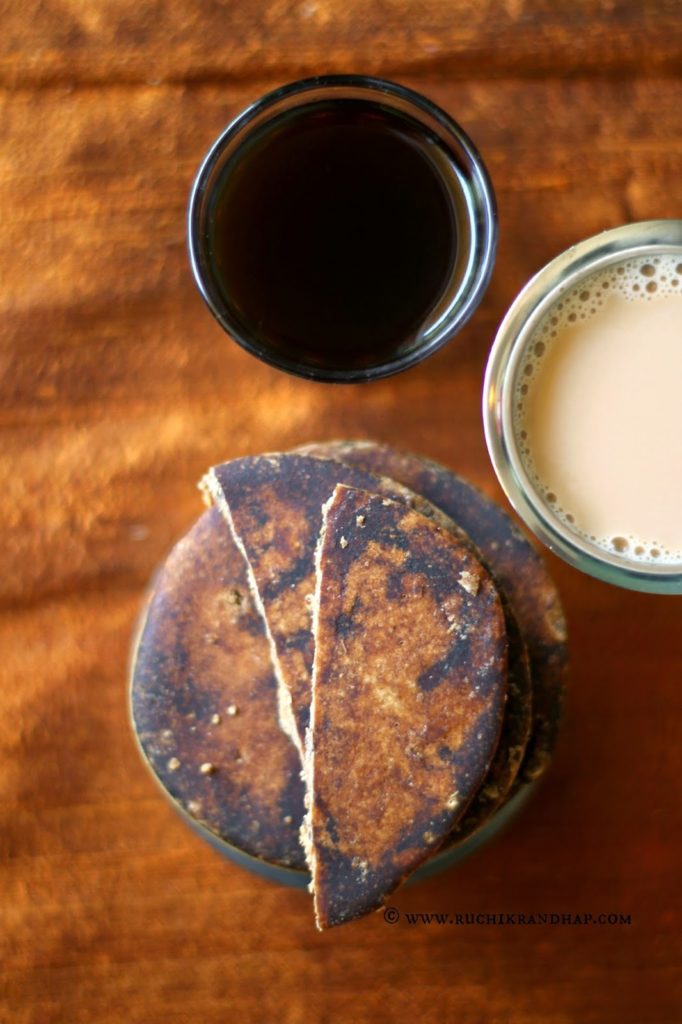
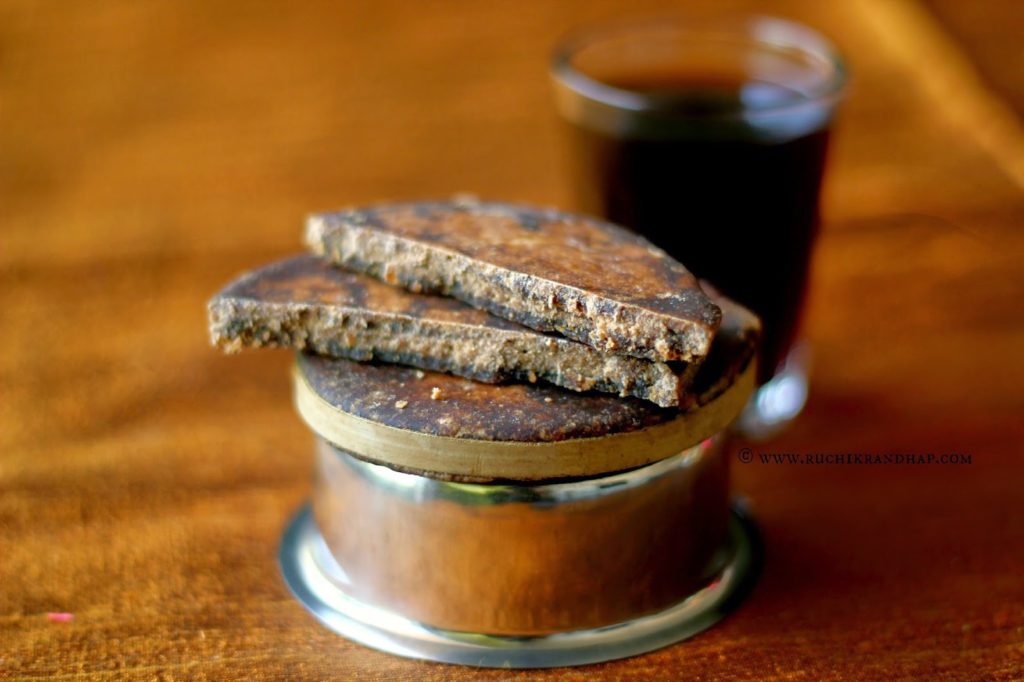
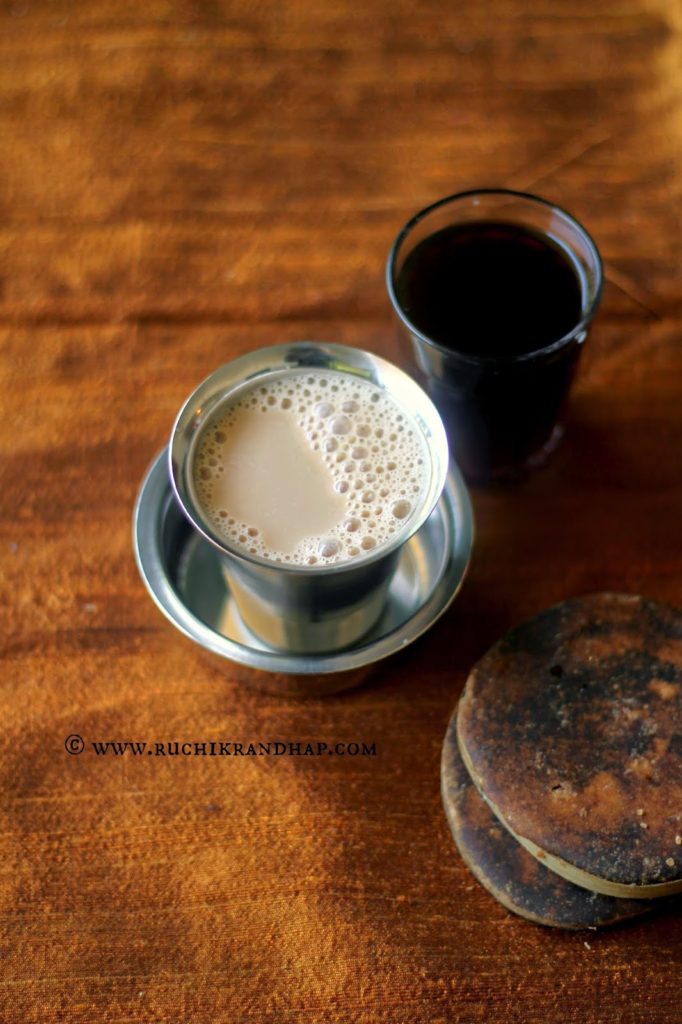
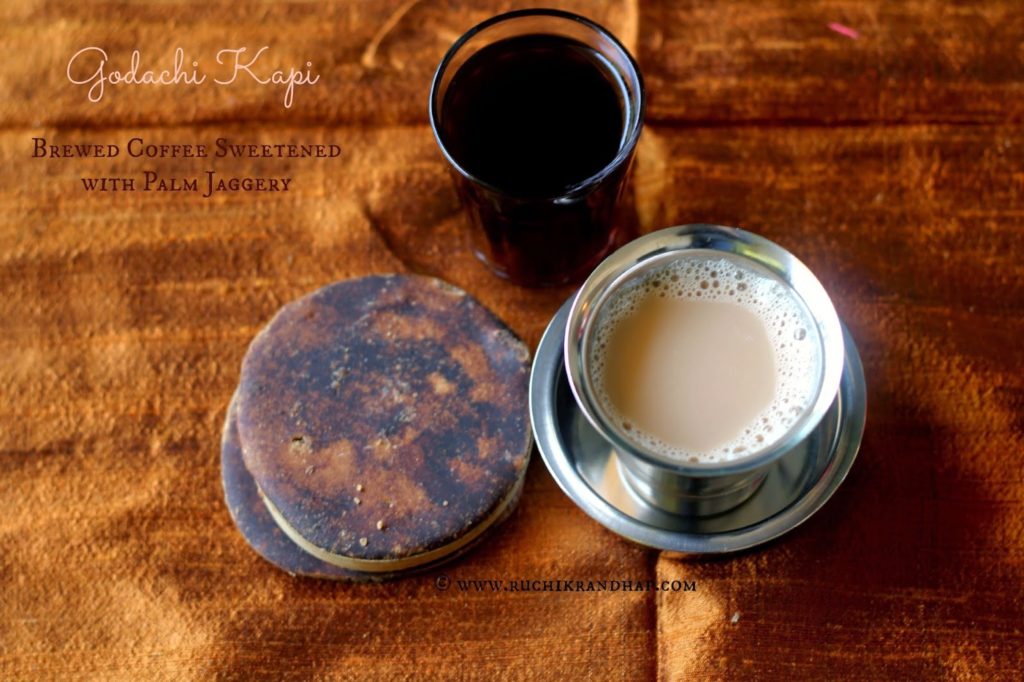
I am so amazed by this post with the amount of information you have packed in it. I used to always just hold those discs of jaggery in Nilgiris supermarket, ponder over them and keep them back not knowing what to do with, this time i will surely pick them up. I have kapha dosha so i will surely know how to take my coffee now. thank you a million times for this wonderful post!!! Also, could you recommend what brand filter coffee is good? I would then be able to get the brand. Again, I thought this post was just incredible and no one should miss reading it <3
@ Coral: Thanks so much for that awesome comment! Do pick up the palm jaggery on your next visit to Nilgiris 🙂 I will post more recipes for it. You can add it to kheers/payasams too!
I picked up the filter coffee from Mangalore. If you live in Karnataka you can look for Panduranga coffee – we have been using this brand for decades at my mum's place so I can't think of any brand in terms of comparison. Hope it helps!
Hi Shireen! Firstly, what gives that I find your post exactly a month after you've posted it?!… and… while I'm sipping on a freshly brewed godachi kapi myself! I loved your post especially since it went beautifully along with my cuppa & the sentiments of visiting Mangalore last week after years.. My first sip took me right back to the early 80s when my grandmother had taken me along to visit for the first time… Well done!
Good information that pelyache god is from ice apple. You said after preparing the coffee tilt and rest for 30 to 45 minutes, how can one have hot coffee by then it gets cold.
Yes, even when filter coffee is made using a filter by the time the coffee dribbles away, it is cold. This is the reason why you should have freshly boiled milk to be added to the coffee.